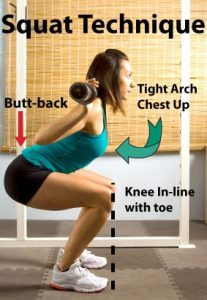1. Use Proper Squatting Technique
Squatting is one of the most common exercises done at the gym… and no doubt, it can be very effective for building thigh strength.
However, if it isn’t done properly, it can cause serious injury to the knee. It can be a difficult exercise to learn, but once you know how to do it, you will be able to have a great workout without causing potentially permanent damage to your knee.
Here are the steps to doing a proper squat:
- Start by straightening your back and pulling your head back. Think of it as the attention position. Your head is pulled up, chest raised, and your back is slightly arched. Don’t bend your back or look down during the squat.
- Once you have taken the weights from the rack and taken a step backwards, make sure that your feet are shoulder width apart. You can have your feet slightly further apart as well.
- Turn your feet outwards to about a 45 degree angle and you are ready to squat.
- Keep your knees in a line with your feet (never allow your knee go further forward that your big toe) and pretend you are sitting in a chair.
- It is important to make sure that your knees don’t bow in during the squat, because it is likely to lead to an injury.

2. Stretch Regularly
Stretching is extremely important to make your body work efficiently and prevent injuries.
We believe that one of the most important stretches for an active person is a hamstring stretch. Hamstring muscle is particularly vulnerable to stiffening. There are different ways to stretch your hamstrings but we believe a lying stretch with a towel is the most effective. Click here to watch a video demonstration of how to do this stretch.
Other important muscle to target with stretching are calves, piriformis, quadriceps, triceps and pecs (chest).
Another structure that often cause problems around the knee is IT band. To release it we recommend using a foam roller. To see how this is done please click here to be directed to our demonstration video on YouTube.
3. Exercises that are impact-oriented should be reduced or supplemented with low-impact exercises
So many people train on treadmills. I will not argue with the fact that running is probably the quickest way to get fit. And I’m not saying you should stop running… not at all.
However, high-impact exercises such as running have a higher potential to hurt your knees.
The use of an elliptical cross-trainer machine is a good low-impact alternative. It allows for the similar areas of your body to be worked without as much impact.
Many people utilize the fluid motion of an elliptical because they find that they are not as sore the next day. It prevents the knees from being jarred as well, which will minimise the risk of knee injuries and pain. It can also prevent pain in the other joints as well, such as the ankle and hip.
I would also suggest that if you enjoy running use stationary bike at least twice a weak to supplement your running training. Not only cycling is a great cardio workout, but it also helps to strengthen vital inner thigh muscles that help to prevent knee injuries.
Preventing a knee injury is very important when exercising.
The whole idea is to continue to improve your fitness, not spend weeks recovering from a knee injury that was totally preventable. And then you have to start from square one again… how frustrating!
If you follow these three steps, you will be able to reduce the likelihood of injury to your knees that can put you out of commission or make it harder to work out and stay healthy.
When it comes to exercising, you want to follow the best advice, so that you can get the best results.
